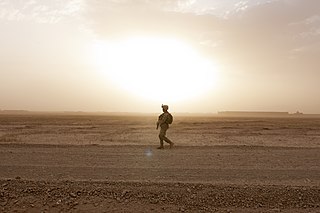
The International Security Assistance Force (ISAF) was a multinational military mission in Afghanistan from 2001 to 2014. It was established by United Nations Security Council Resolution 1386 pursuant to the Bonn Agreement, which outlined the establishment of a permanent Afghan government following the U.S. invasion in October 2001. ISAF's primary goal was to train the Afghan National Security Forces (ANSF) and assist Afghanistan in rebuilding key government institutions; it gradually took part in the broader war in Afghanistan against the Taliban insurgency.

Below is the disposition and structure of international military forces that were participating in the War in Afghanistan in November 2012, listing deployed units under the command of the International Security Assistance Force (ISAF), which controlled both combat and reconstruction operations. During its existence from 2001 to 2014, ISAF comprised units from many countries. In this article, units are assumed to be from the United States unless otherwise stated. This list is a rough and unofficial listing of units and formations.

Operation Herrick was the codename under which all British operations in the War in Afghanistan were conducted from 2002 to the end of combat operations in 2014. It consisted of the British contribution to the NATO-led International Security Assistance Force (ISAF), and support to the American-led Operation Enduring Freedom (OEF), within the central Asian country.

Nawzad is a small town, the centre of Nawzad District in Helmand Province, Afghanistan. It is located at 32.4000°N 64.4667°E at an altitude of 1221 metres ASL. It was the site of the Battle of Nawzad.

Following the terrorist attacks of September 11, 2001, several nations took on Al-Qaeda and the Taliban during Operation Enduring Freedom (OEF) in Afghanistan. OEF was the initial combat operations starting on 7 October 2001, in the wake of the 11 September attacks on the United States, and during 2002 and 2003.

Camp Shorabak is a former British Army airbase, located northwest of the city of Lashkargah in Helmand Province, Afghanistan. The camp was situated in a remote desert area, far from population centres.

The Helmand province campaign was a series of military operations conducted by the International Security Assistance Force (ISAF) forces against Taliban insurgents and other local groups in the Helmand Province of Afghanistan. Their objective was to control a province that was known to be a Taliban stronghold, and a center of opium production. None of the ISAF's intended strategic and political objectives were achieved in the long term.
The Battle of Musa Qala was a British-led military action in Helmand Province, southern Afghanistan, launched by the Afghan National Army and the International Security Assistance Force (ISAF) against the Taliban on 7 December 2007. After three days of intense fighting, the Taliban retreated into the mountains on 10 December. Musa Qala was officially reported captured on 12 December, with Afghan Army troops pushing into the town centre.

US and NATO International Security Assistance Force (ISAF) operations, alongside Afghan National Army forces, continued against the Taliban through 2007.

The Estonian Defence Forces is the unified military force of the Republic of Estonia. The Estonian Defence Forces consists of the Estonian Land Forces, the Estonian Navy, the Estonian Air Force, and the paramilitary Estonian Defence League. The national defence policy aims to guarantee the preservation of the independence and sovereignty of the state, the integrity of its land area, territorial waters, airspace and its constitutional order. Its main goals remain the development and maintenance of a credible capability to defend the nation's vital interests and development of the defence forces in a way that ensures their interoperability with the armed forces of NATO and European Union member states to participate in the full range of missions for these military alliances.
United States and NATO International Security Assistance Force (ISAF) operations, alongside Afghan National Army forces, continued against the Taliban through 2008.

The Helmand Provincial Reconstruction Team (HPRT) was established in September 2004. It was led by the US until 1 May 2006, when this responsibility was handed to the UK. HPRT ceased operations in Lashkar Gah on 27 December 2013.

The Estonian Iraqi Contingent or was a joint military force of the Estonian Defence Forces deployed mainly in the Baghdad Governorate in Sab-al-Bori area.
The Estonian Kosovo Contingent or is a joint military force of the Estonian Defence Forces deployed in northern Kosovo, in the area of Kosovska Mitrovica.
Allain Tikko was an Estonian warrant officer (veebel) in charge of a jagu in ESTCOY-8, which had been posted in Afghanistan as a part of United Kingdom's military operations, itself a part of NATO continuing operations in Afghanistan.

Operation Panchai Palang, or Panther's Claw, was a British-led military operation of the War in Afghanistan in Helmand Province in southern Afghanistan. It aimed to secure various canal and river crossings to establish a permanent International Security Assistance Force (ISAF) presence in the area. The commander of the operation declared the first stage a success on 27 July 2009.
The Battle of Nawzad (2006–2014) was a battle between ISAF (coalition) forces and Taliban insurgents in Nawzad at the center of Nawzad district in the northern half of Helmand Province, southern Afghanistan.
Task Force Helmand was the name given to a military unit of the International Security Assistance Force in Helmand Province, Afghanistan. Task Force Helmand was part of Regional Command Southwest and consisted primarily of personnel from the British Armed Forces, as well as contribution from NATO allies Denmark and Estonia. It was established in April 2006, which coincided with the deployment of Operation Herrick 4.

Georgia joined the war in Afghanistan in 2004 and the country had become the largest non-NATO and the largest per capita troop contributor to the International Security Assistance Force in Afghanistan by late 2012, with over 1,560 personnel on the ground as of May 2013. At its peak deployment, Georgia provided two full infantry battalions serving with the United States forces in the Helmand province. Since the beginning of their mission, more than 11,000 Georgian soldiers have served in Afghanistan.












